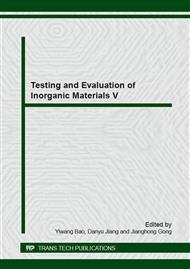p.455
p.459
p.463
p.467
p.472
p.476
p.480
p.485
p.490
Determining the Thermal Shock Elastic Behavior of Mullite Ceramic Regenerator Material by Ultrasonic Testing
Abstract:
Mullite material is a material commonly used in honeycomb regenerator, because in the process of using material under big temperature difference effect, so have a great demand for its thermal shock resistance. The used mullite ceramics were made by the direct solid phase sintering method, and the modulus of elasticity of the mullite ceramics measured by ultrasonic pulse-echo method in a thermal shock and thermal fatigue experiment, respectively. In the air-cooling condition, the study found the mullite ceramic without thermal shock that the longitudinal wave velocity and shear wave velocity respectively 3970(m/s) and 2492(m/s). After 45 times thermal shock of temperature difference of 800°C, longitudinal wave velocity and shear wave velocity decreased to 3910(m/s) and 2457(m/s), and the value of the modulus of elasticity changed 1020MPa. By observing the change of the elastic modulus value rule, can know the elastic deformation of thermal shock on the material performance of thermal shock damage. Moreover, the results can provide the data basis for the calculation of the residual strength and the numerical simulation of thermal stress.
Info:
Periodical:
Pages:
472-475
Citation:
Online since:
November 2014
Authors:
Keywords:
Price:
Сopyright:
© 2015 Trans Tech Publications Ltd. All Rights Reserved
Share:
Citation:


